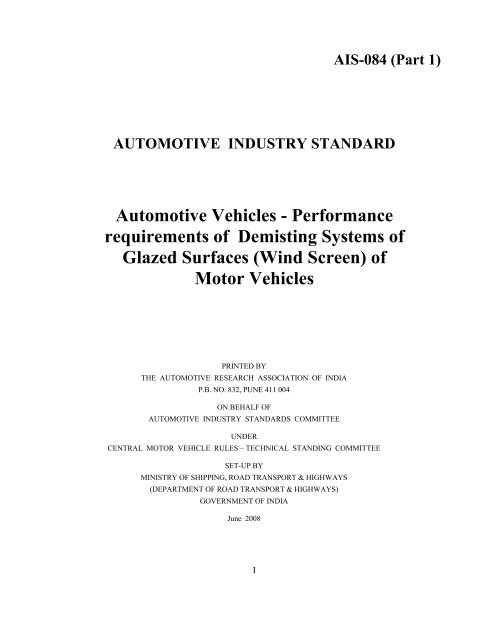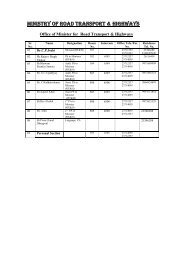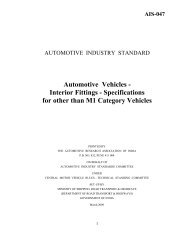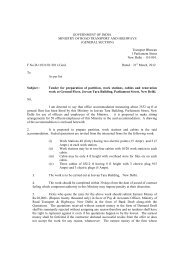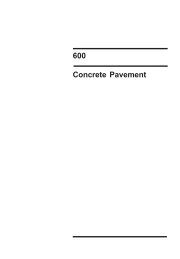AIS-084 (Part 1) - Ministry of Road Transport and Highways
AIS-084 (Part 1) - Ministry of Road Transport and Highways
AIS-084 (Part 1) - Ministry of Road Transport and Highways
You also want an ePaper? Increase the reach of your titles
YUMPU automatically turns print PDFs into web optimized ePapers that Google loves.
<strong>AIS</strong>-<strong>084</strong> (<strong>Part</strong> 1)<br />
AUTOMOTIVE INDUSTRY STANDARD<br />
Automotive Vehicles - Performance<br />
requirements <strong>of</strong> Demisting Systems <strong>of</strong><br />
Glazed Surfaces (Wind Screen) <strong>of</strong><br />
Motor Vehicles<br />
PRINTED BY<br />
THE AUTOMOTIVE RESEARCH ASSOCIATION OF INDIA<br />
P.B. NO. 832, PUNE 411 004<br />
ON BEHALF OF<br />
AUTOMOTIVE INDUSTRY STANDARDS COMMITTEE<br />
UNDER<br />
CENTRAL MOTOR VEHICLE RULES – TECHNICAL STANDING COMMITTEE<br />
SET-UP BY<br />
MINISTRY OF SHIPPING, ROAD TRANSPORT & HIGHWAYS<br />
(DEPARTMENT OF ROAD TRANSPORT & HIGHWAYS)<br />
GOVERNMENT OF INDIA<br />
June 2008<br />
I
<strong>AIS</strong>-<strong>084</strong> (<strong>Part</strong> 1)<br />
Status chart <strong>of</strong> the St<strong>and</strong>ard to be used by the purchaser for updating the<br />
record<br />
Sr.<br />
No.<br />
Corrigenda.<br />
Amendment<br />
Revision Date Remark Misc.<br />
General Remarks:<br />
II
<strong>AIS</strong>-<strong>084</strong> (<strong>Part</strong> 1)<br />
INTRODUCTION<br />
The Government <strong>of</strong> India felt the need for a permanent agency to expedite the<br />
publication <strong>of</strong> st<strong>and</strong>ards <strong>and</strong> development <strong>of</strong> test facilities in parallel when the<br />
work on the preparation <strong>of</strong> the st<strong>and</strong>ards is going on, as the development <strong>of</strong><br />
improved safety critical parts can be undertaken only after the publication <strong>of</strong> the<br />
st<strong>and</strong>ard <strong>and</strong> commissioning <strong>of</strong> test facilities. To this end, the erstwhile <strong>Ministry</strong><br />
<strong>of</strong> Surface <strong>Transport</strong> (MOST) has constituted a permanent Automotive Industry<br />
St<strong>and</strong>ards Committee (<strong>AIS</strong>C) vide order No.RT-11028/11/97-MVL dated<br />
September 15, 1997. The st<strong>and</strong>ards prepared by <strong>AIS</strong>C will be approved by the<br />
permanent CMVR -Technical St<strong>and</strong>ing Committee (CTSC). After approval, the<br />
Automotive Research Association <strong>of</strong> India, (ARAI), Pune, being the Secretariat <strong>of</strong><br />
the <strong>AIS</strong> Committee, has published this st<strong>and</strong>ard.<br />
The subject <strong>of</strong> demisting <strong>and</strong> defrosting systems was identified in <strong>Road</strong> Map for<br />
Automotive Safety Regulations for formulation <strong>of</strong> <strong>AIS</strong>. The formation <strong>of</strong> mist<br />
<strong>and</strong> frost reduces the driver’s visibility, which is important for safety. The purpose<br />
<strong>of</strong> this st<strong>and</strong>ard is to ensure good visibility under certain climatic conditions by<br />
providing demist <strong>and</strong> defrost systems for the windscreens.<br />
While formulating the st<strong>and</strong>ard <strong>and</strong> considering climatic conditions in the country<br />
<strong>and</strong> its implementation, the st<strong>and</strong>ard is formulated in two parts specifying the<br />
requirements for demisting <strong>and</strong> defrosting systems separately as <strong>AIS</strong>-<strong>084</strong> (<strong>Part</strong> 1)<br />
<strong>and</strong> <strong>AIS</strong>-<strong>084</strong> (<strong>Part</strong> 2) respectively.<br />
While preparing this <strong>AIS</strong> considerable assistance is derived from EEC Directive<br />
78/317/EEC on the approximation <strong>of</strong> the laws <strong>of</strong> the Member States relating<br />
to the Defrosting <strong>and</strong> Demisting Systems <strong>of</strong> Glazed Surfaces <strong>of</strong> Motor<br />
Vehicles.<br />
The Automotive Industry St<strong>and</strong>ards Committee responsible for preparation <strong>of</strong> this<br />
st<strong>and</strong>ard is given in Annex : VI<br />
III
Automotive Vehicles - Performance requirements <strong>of</strong><br />
Demisting Systems <strong>of</strong> Glazed Surfaces (Wind Screen) <strong>of</strong><br />
Motor Vehicles<br />
1. SCOPE<br />
1.1. This st<strong>and</strong>ard applies to the 180° forward field <strong>of</strong> vision <strong>of</strong> the drivers <strong>of</strong><br />
vehicles in category M1 as defined in <strong>AIS</strong>-053.<br />
1.2 Requirements <strong>of</strong> demisting systems <strong>of</strong> this st<strong>and</strong>ard are not applicable to<br />
the vehicles, which are not sealed from external environment e.g. s<strong>of</strong>t top,<br />
open bodied or incomplete vehicle, with agreement <strong>of</strong> test agency.<br />
1.3 Its purpose is to ensure good visibility under certain conditions by<br />
specifying the requirements for demisting systems for the windscreens <strong>of</strong><br />
category M1 vehicles.<br />
2. 0 REFERENCES<br />
2.1 <strong>AIS</strong>-053 Automotive Vehicles – Types – Terminology.<br />
2.2 <strong>AIS</strong>-021 Field <strong>of</strong> Vision <strong>of</strong> Motor Vehicle Drivers for M1 Category.<br />
2.3 IS: 9211-2003 Terms <strong>and</strong> Definitions <strong>of</strong> Weights <strong>of</strong> <strong>Road</strong> Vehicles other<br />
than 2 And 3 Wheelers (Second Revision)<br />
3.0 DEFINITIONS<br />
3.1 Mist<br />
'Mist' means a film <strong>of</strong> condensate on the inside face <strong>of</strong> the glazed surfaces.<br />
3.2 Demisting<br />
'Demisting means the elimination <strong>of</strong> the mist covering the glazed surfaces<br />
by the operation <strong>of</strong> the demisting system.<br />
3.3 Demisting System<br />
'Demisting system' means the system intended to remove a film <strong>of</strong><br />
condensate on the inside surface <strong>of</strong> the windscreen <strong>and</strong> thus restore<br />
visibility.<br />
3.4 Vehicle Type<br />
'Vehicle type with regard to the windscreen demisting systems means<br />
vehicles which do not differ in such essential respects as:<br />
3.4.1 the external <strong>and</strong> internal forms <strong>and</strong> arrangements within the area specified<br />
in clause 1, which may affect visibility;<br />
3.4.2 the shape, size <strong>and</strong> characteristics <strong>of</strong> the windscreen <strong>and</strong> its mounting;<br />
3.4.3 the characteristics <strong>of</strong> the demisting systems;<br />
3.4.4 the number <strong>of</strong> seats.<br />
<strong>AIS</strong>-<strong>084</strong> (<strong>Part</strong> 1)<br />
1/20
3.5 Three-dimensional Reference Grid<br />
'Three-dimensional reference grid' means a reference system, which<br />
consists <strong>of</strong> a vertical longitudinal plane X-Z, a horizontal plane X-Y <strong>and</strong> a<br />
vertical transverse plane Y-Z (see Figure 2 <strong>of</strong> Annex III). The grid is used<br />
to determine the dimensional relationships between the position <strong>of</strong> design<br />
points on drawings <strong>and</strong> their position on the actual vehicle. The procedure<br />
for situating the vehicle relative to the grid is specified in Annex III; all coordinates<br />
referred to ground zero shall be based on a vehicle in running<br />
order as defined in 3.5.1.<br />
3.5.1 Vehicle in running order means kerb weight <strong>of</strong> the complete vehicle<br />
(unladden weight) as defined in cl. 3.6 <strong>of</strong> IS: 9211-2003, plus driver <strong>and</strong><br />
one front seat passenger, the weight <strong>of</strong> driver <strong>and</strong> passenger being<br />
75 kg ± 1%.<br />
.<br />
3.5.2 Vehicles fitted with suspension enabling their ground clearance to be<br />
adjusted shall be tested under the normal conditions <strong>of</strong> use<br />
specified by the vehicle manufacturer.<br />
3.6 Primary Reference Marks<br />
'Primary reference marks' means holes, surfaces, marks <strong>and</strong> identification<br />
signs on the vehicle body. The type <strong>of</strong> reference mark used <strong>and</strong> the<br />
position <strong>of</strong> each mark relative to the X, Y <strong>and</strong> Z co-ordinates <strong>of</strong> the threedimensional<br />
reference grid <strong>and</strong> to a design ground plane shall be specified<br />
by the vehicle manufacturer. These marks may be the control points used<br />
for body-assembly purposes.<br />
3.7 Seat-back Angle<br />
(See Annex II).<br />
3.8 Actual Seat-back Angle<br />
(See Annex II).<br />
3.9 Design Seat-back Angle<br />
(See Annex II).<br />
3.10 V Points<br />
'V points' means points whose position in the passenger compartment is<br />
determined by vertical longitudinal planes passing through the centres <strong>of</strong><br />
the outermost designated seating positions on the front seat <strong>and</strong> in relation<br />
to the R point <strong>and</strong> the design angle <strong>of</strong> the seat back, which points are used<br />
for verifying compliance with the field-<strong>of</strong>-view requirements<br />
(see Annex IV).<br />
<strong>AIS</strong>-<strong>084</strong> (<strong>Part</strong> 1)<br />
2/20
3.11 R Point or Seating Reference Point<br />
(See Annex II).<br />
3.12 H Point<br />
(See Annex II).<br />
3.13 Windscreen Datum Points<br />
'Windscreen datum points' means points situated at the intersection with<br />
the windscreen <strong>of</strong> lines radiating forward from the V points to the outer<br />
surface <strong>of</strong> the windscreen.<br />
3.14 Transparent Area <strong>of</strong> a Windscreen<br />
'Transparent area <strong>of</strong> a windscreen' means that area <strong>of</strong> a vehicle windscreen<br />
whose light transmittance, measured at right angles to the surface, is not<br />
less than 70%.<br />
3.15 Horizontal Seat-adjustment Range<br />
'Horizontal seat-adjustment range' means the range <strong>of</strong> normal driving<br />
positions designated by the vehicle manufacturer for the adjustment <strong>of</strong> the<br />
driver's seat in the direction <strong>of</strong> the X axis ( see 3.5 ).<br />
3.16 Extended Seat-adjustment Range<br />
'Extended seat-adjustment range' means the range designated by the<br />
vehicle manufacturer for the adjustment <strong>of</strong> the seat in the direction <strong>of</strong> the<br />
X axis ( see 3.5 ) beyond the range <strong>of</strong> normal driving positions specified in<br />
3.15 <strong>and</strong> used for converting seats into beds or facilitating entry into the<br />
vehicle.<br />
4.0 TECHNICAL INFORMATION TO BE SUBMITTED BY<br />
VEHICLE MANUFACTURER<br />
4.1 The application for type-approval <strong>of</strong> a vehicle type with regard to its<br />
windscreen demisting system shall be submitted by the vehicle<br />
manufacturer or by his authorised representative.<br />
4.2 It shall be accompanied by the documents in triplicate <strong>and</strong> by the<br />
particulars as per Annex : I<br />
5. SPECIFIC REQUIREMENTS<br />
5.1. Windscreen Demisting<br />
5.1.1 Every vehicle shall be equipped with a system for removing mist from the<br />
interior glazed surface <strong>of</strong> the windscreen.<br />
5.1.2 The demisting system shall be effective enough to restore visibility<br />
through the windscreen in wet weather. Its efficiency shall be verified by<br />
the procedure described in 6.1.<br />
<strong>AIS</strong>-<strong>084</strong> (<strong>Part</strong> 1)<br />
3/20
5.1.3 The following requirements shall be satisfied:<br />
<strong>AIS</strong>-<strong>084</strong> (<strong>Part</strong> 1)<br />
5.1.3.1 the area defined in 2.2 <strong>of</strong> Annex IV (area A) shall be 90% demisted<br />
in 10 minutes;<br />
5.1.3.2 the area defined in 2.3 <strong>of</strong> Annex IV (area B) shall be 80% demisted<br />
in 10 minutes.<br />
6. TEST PROCEDURE<br />
6.1. Windscreen Demisting<br />
6.1.1. Before the test, the inside surface <strong>of</strong> the windscreen shall be thoroughly<br />
degreased by means <strong>of</strong> methylated spirit, or an equivalent degreasing<br />
agent. After drying, a solution <strong>of</strong> ammonia <strong>of</strong> not less than 3% <strong>and</strong> not<br />
more than 10% shall be applied. The surface shall be allowed to dry again<br />
<strong>and</strong> then be wiped with a dry, cotton cloth.<br />
6.1.2. The test shall be carried out in an environmental chamber large enough to<br />
take the complete vehicle <strong>and</strong> capable <strong>of</strong> producing <strong>and</strong> maintaining a test<br />
temperature <strong>of</strong> - 3 ± 1ºC throughout the test period.<br />
6.1.2.1.The temperature in the test chamber shall be measured at the level <strong>of</strong> the<br />
centre <strong>of</strong> the windscreen, at a point not significantly affected by heat from<br />
the vehicle under test.<br />
6.1.2.2. The horizontal component <strong>of</strong> the speed <strong>of</strong> the air cooling the chamber,<br />
measured immediately prior to the test, in the median plane <strong>of</strong> the vehicle<br />
at a point 300 mm forward <strong>of</strong> the base <strong>of</strong> the windscreen <strong>and</strong> at a level<br />
half-way between the base <strong>and</strong> the top <strong>of</strong> the windscreen, shall be as low<br />
as possible <strong>and</strong> in any event less than 8 km/h;<br />
6.1.2.3. The engine bonnet, the doors <strong>and</strong> the vents, except the intakes <strong>and</strong> outlets<br />
<strong>of</strong> the heating <strong>and</strong> ventilation system, shall be closed; one or two windows<br />
may be opened from the beginning <strong>of</strong> the demisting test for a total vertical<br />
distance <strong>of</strong> 25 mm if the vehicle manufacturer so requests.<br />
6.1.3. The mist shall be produced by means <strong>of</strong> the steam generator described in<br />
Annex V. The generator shall contain enough water to generate at least<br />
70 ± 5 g/h <strong>of</strong> steam for each seating position designated by the<br />
manufacturer, in an ambient temperature <strong>of</strong>- 3 ± 1° C.<br />
6.1.4 The inside surface <strong>of</strong> the windscreen shall be cleaned as prescribed<br />
in 6.1.1 <strong>and</strong> the vehicle placed in the environmental chamber. The ambient<br />
air temperature shall be lowered until the temperature <strong>of</strong> the engine<br />
coolant, the lubricants <strong>and</strong> the air inside the vehicle are stabilised<br />
at – 3 ± 1 ºC.<br />
6.1.5 The steam generator shall be placed with its outlets in the median plane <strong>of</strong><br />
the vehicle at a height <strong>of</strong> 580 ± 80 mm above the R point <strong>of</strong> the driver's<br />
seat. It shall normally be placed immediately behind the front seat<br />
backrest, with the seat-back, if adjustable, set at the prescribed angle.<br />
Where the design <strong>of</strong> the vehicle precludes this, the generator may be<br />
placed in front <strong>of</strong> the backrest, in the nearest convenient position to that<br />
mentioned above.<br />
4/20
6.1.6 After the generator has been operating for five minutes inside the vehicle,<br />
one or two observers shall enter the front <strong>of</strong> the vehicle, the output <strong>of</strong> the<br />
generator being then reduced by 70 ± 5 g/h for each observer.<br />
6.1.7 One minute after the observer or observers have entered the vehicle, the<br />
engine shall be started as indicated by the manufacturer. The test period<br />
shall commence as soon as the engine is running.<br />
6.1.7.1 Throughout the test the engine shall run:<br />
6.1.7.1.1 at a speed not exceeding 50% <strong>of</strong> the speed corresponding to its<br />
maximum power output; moreover,<br />
6.1.7.1.2. the vehicle demister controls shall be set as recommended by the vehicle<br />
manufacturer for the test temperature.<br />
6.1.7.1.3. the battery shall be fully charged;<br />
6.1.7.1.4. the voltage at the terminals <strong>of</strong> the demisting device may be not more<br />
than 20% above the nominal rating <strong>of</strong> the system.<br />
6.1.8. At the end <strong>of</strong> the test, the demist pattern shall be recorded.<br />
7.0 MODIFICATIONS AND EXTENSION OF APPROVAL FOR<br />
DEMISTING SYSTEM<br />
7.1 Every modification pertaining to the information, even if the changes are<br />
not technical in nature declared in accordance with clause 4, shall be<br />
intimated by the manufacturer to the test agency.<br />
If the changes are in parameters not related to the provisions, no further<br />
action need be taken.<br />
If the changes are in parameters related to the provisions, the test agency,<br />
which has issued the certificate <strong>of</strong> compliance, may then consider, based<br />
on the justification provided by the vehicle manufacturer <strong>and</strong> reviewed<br />
by the test agency, whether,<br />
7.1.1 the model with the changed specifications still complies with provisions;<br />
or,<br />
7.1.2 any further verification is required to establish compliance.<br />
7.2. In case <strong>of</strong> 7.1.2, tests for only those parameters which are affected by the<br />
modifications need be carried out.<br />
7.3. In case <strong>of</strong> fulfillment <strong>of</strong> criterion <strong>of</strong> clause 7.1.1 or after results <strong>of</strong> further<br />
verification as per clause 7.1.2 are satisfactory, the approval <strong>of</strong><br />
compliance shall be extended for the changes carried out.<br />
<strong>AIS</strong>-<strong>084</strong> (<strong>Part</strong> 1)<br />
5/20
ANNEX I<br />
(See 4.2)<br />
TECHNICAL INFORMATION TO BE SUBMITTED BY<br />
VEHICLE MANUFACTURER<br />
1. A description <strong>of</strong> the vehicle referring to the criteria mentioned in 3.4 <strong>of</strong><br />
this st<strong>and</strong>ard, together with dimensional drawings <strong>and</strong> either a photograph<br />
or an exploded view <strong>of</strong> the passenger compartment. The numbers <strong>and</strong>/or<br />
symbols identifying the vehicle type shall be specified.<br />
2. <strong>Part</strong>iculars <strong>of</strong> the primary reference marks in sufficient detail to enable<br />
them to be readily identified <strong>and</strong> the position <strong>of</strong> each in relation to the<br />
others <strong>and</strong> to the R point to be verified;<br />
3. a technical description <strong>of</strong> the demisting systems, together with relevant<br />
data in sufficient detail.<br />
4. In addition, following technical information shall be submitted by vehicle<br />
manufacturer<br />
1. Manufacturer’s name <strong>and</strong> plant address<br />
2. Trade name or mark <strong>of</strong> the vehicle<br />
3. Complete vehicle kerb weight ( unladden weight)<br />
as per clause 3.5.1<br />
4. Test to be conducted:<br />
Demisting Systems<br />
5. Details <strong>of</strong> demisting systems :<br />
i) Schematic diagram <strong>of</strong> engine cooling system.<br />
ii) Schematic diagram <strong>of</strong> heating system.<br />
iii) Cross sectional view <strong>of</strong> complete air h<strong>and</strong>ling system<br />
including position <strong>of</strong> louvers ( vents) on dash board.<br />
iv) Blower identification <strong>and</strong> capacity (Watts).<br />
6. R point w.r.t primary reference marks<br />
7. Manufacturers recommended seat back angle<br />
8. Manufacturers recommended driver seat travel distance<br />
9. Seating Layout<br />
10. Windscreen glass specifications (type, thickness <strong>and</strong> make)<br />
11. Windscreen glass fixing method<br />
12. Rake angle <strong>of</strong> windscreen<br />
13. Engine specification (fuel, capacity cc, engine speed at max.<br />
power in rpm).<br />
14. Rated voltage <strong>of</strong> electrical installation<br />
<strong>AIS</strong>-<strong>084</strong> (<strong>Part</strong> 1)<br />
6/20
ANNEX II<br />
(See 3.7 to 3.9)<br />
PROCEDURE FOR DETERMINING THE H POINT AND THE ACTUAL<br />
SEAT-BACK ANGLE AND FOR VERIFYING THE RELATIVE<br />
POSITIONS OF THE R AND H POINTS AND THE RELATIONSHIP<br />
BETWEEN THE DESIGN SEAT-BACK ANGLE AND THE ACTUAL<br />
SEAT-BACK ANGLE<br />
<strong>AIS</strong>-<strong>084</strong> (<strong>Part</strong> 1)<br />
1.0 Annexure : I <strong>of</strong> <strong>AIS</strong>-021 shall be applicable.<br />
7/20
<strong>AIS</strong>-<strong>084</strong> (<strong>Part</strong> 1)<br />
ANNEX III<br />
(See 3.5 <strong>and</strong> Annex IV-1.2)<br />
METHOD FOR DETERMINING THE DIMENSIONAL RELATIONSHIPS<br />
BETWEEN THE VEHICLE'S PRIMARY REFERENCE MARKS AND<br />
THE THREE DIMENSIONAL REFERENCE GRID<br />
1. RELATIONSHIP BETWEEN REFERENCE GRID AND<br />
VEHICLE'S PRIMARY REFERENCE MARKS<br />
To verify specific dimensions on or within a vehicle submitted for typeapproval<br />
in accordance with this st<strong>and</strong>ard, the relationship between the<br />
co-ordinates <strong>of</strong> the three-dimensional reference grid defined in 3.5 <strong>of</strong> this<br />
st<strong>and</strong>ard, which have been laid out at the initial vehicle-design stage, <strong>and</strong><br />
the positions <strong>of</strong> the primary reference marks defined in 3.6 <strong>of</strong> this<br />
st<strong>and</strong>ard, shall be established accurately so that specific points on the<br />
vehicle manufacturer's drawings can be located on an actual vehicle<br />
produced from those drawings.<br />
2. METHOD FOR ESTABLISHING RELATIONSHIP OF<br />
REFERENCE GRID TO REFERENCE MARKS<br />
For this purpose, a ground reference plane shall be constructed, which is<br />
marked with the X-X measurement <strong>and</strong> the Y-Y measurement. The<br />
method <strong>of</strong> achieving this is set out in Figure 3 <strong>of</strong> this Annex, the reference<br />
plane being a hard, flat, level surface on which the vehicle st<strong>and</strong>s, <strong>and</strong><br />
which has two measuring scales firmly fixed to its surface; these shall be<br />
graduated in millimeters, the X-X scale being not less than 8 m long, <strong>and</strong><br />
the Y-Y scale not less than 4 m long. The two scales shall be set at right<br />
angles to each other as shown in Figure 3 <strong>of</strong> this Annex. The intersection<br />
<strong>of</strong> the scales is ground zero.<br />
3. EXAMINATION OF THE REFERENCE PLANE<br />
In order to provide for minor variations in the level <strong>of</strong> the reference plane<br />
or test area, it is necessary to measure the deviations from ground zero<br />
along both the X <strong>and</strong> Y scales at intervals <strong>of</strong> 250 mm <strong>and</strong> to record the<br />
readings obtained so that corrections can be made when checking the<br />
vehicle.<br />
4. ACTUAL TEST ATTITUDE<br />
In order to provide for minor changes in suspension height, etc., it is<br />
necessary to have available a means <strong>of</strong> bringing the primary reference<br />
marks to the correct co-ordinate positions relative to the design attitude<br />
before further measurements are taken. In addition, it shall be possible to<br />
make minor lateral <strong>and</strong>/or longitudinal adjustments to the vehicle's<br />
position so as to place it correctly in relation to the reference grid.<br />
8/20
<strong>AIS</strong>-<strong>084</strong> (<strong>Part</strong> 1)<br />
5. RESULTS<br />
The vehicle having been correctly placed relative to the reference grid <strong>and</strong><br />
in its design attitude, the site <strong>of</strong> the necessary points for studying the<br />
forward visibility requirements can be readily determined. Test methods to<br />
determine these requirements may include the use <strong>of</strong> theodolites, light<br />
sources or shadow devices, or any other method which can be shown to<br />
give equivalent results.<br />
9/20
<strong>AIS</strong>-<strong>084</strong> (<strong>Part</strong> 1)<br />
a = 68 mm<br />
b = 5 mm<br />
c = 589 mm<br />
d = 665 mm<br />
Figure 1<br />
Determination <strong>of</strong> V Points for a Seat-back Angle <strong>of</strong> 25<br />
10/20
<strong>AIS</strong>-<strong>084</strong> (<strong>Part</strong> 1)<br />
Figure-2<br />
Three-dimensional Reference Grid<br />
11/20
<strong>AIS</strong>-<strong>084</strong> (<strong>Part</strong> 1)<br />
Figure 3<br />
Level Work Space<br />
12/20
<strong>AIS</strong>-<strong>084</strong> (<strong>Part</strong> 1)<br />
ANNEX IV<br />
(See 3.10, 5.1.3.1 <strong>and</strong> 5.1.3.2)<br />
PROCEDURE FOR DETERMINING VISION AREAS ON<br />
WINDSCREENS OF<br />
CATEGORY M1 VEHICLES IN RELATION TO THE V POINTS<br />
1. POSITIONS OF THE V POINTS<br />
1.1 The positions <strong>of</strong> the V points in relation to the R point, as indicated by<br />
XYZ co-ordinates from the three-dimensional reference grid, are as shown<br />
in Tables 1 <strong>and</strong> 2.<br />
1.2 Table 1 indicates the basic co-ordinates for a design seat-back angle <strong>of</strong> 25°<br />
The positive direction for the co-ordinates is indicated in Figure 1 <strong>of</strong><br />
Annex III.<br />
Table 1<br />
V point X Y Z<br />
V1 68 mm - 5 mm 665 mm<br />
V2 68 mm - 5 mm 589 mm<br />
1.3 Correction for Design Seat-back Angles other than 25°<br />
1.3.1 Table 2 shows the further corrections to be made to the X <strong>and</strong> Z<br />
co-ordinates <strong>of</strong> each V point when the design seat-back angle is not<br />
25°. The positive direction for the co-ordinates is shown in Figure 1 <strong>of</strong><br />
Annex III<br />
13/20
<strong>AIS</strong>-<strong>084</strong> (<strong>Part</strong> 1)<br />
Table 2<br />
Seat-back<br />
angle<br />
(in °)<br />
5<br />
6<br />
7<br />
8<br />
9<br />
10<br />
11<br />
12<br />
13<br />
14<br />
15<br />
16<br />
17<br />
18<br />
19<br />
20<br />
21<br />
22<br />
Horizontal<br />
Coordinates<br />
∆ X<br />
-186 mm<br />
-177 mm<br />
-167 mm<br />
157 mm<br />
-147 mm<br />
-137 mm<br />
-128 mm<br />
-118 mm<br />
-109 mm<br />
- 99 mm<br />
- 90 mm<br />
- 81 mm<br />
- 72 mm<br />
- 62 mm<br />
- 53 mm<br />
- 44 mm<br />
- 35 mm<br />
- 26 mm<br />
Vertical<br />
coordinates<br />
∆ Z<br />
28 mm<br />
27 mm<br />
27 mm<br />
27 mm<br />
26 mm<br />
25 mm<br />
24 mm<br />
23 mm<br />
22 mm<br />
21 mm<br />
20 mm<br />
18 mm<br />
17 mm<br />
15 mm<br />
13 mm<br />
11 mm<br />
9 mm<br />
7 mm<br />
Seat-back<br />
angle<br />
(in °)<br />
23<br />
24<br />
25<br />
26<br />
27<br />
28<br />
29<br />
30<br />
31<br />
32<br />
33<br />
34<br />
35<br />
36<br />
37<br />
38<br />
39<br />
40<br />
Horizontal<br />
angle<br />
∆ X<br />
-18 mm<br />
- 9 mm<br />
0 mm<br />
9 mm<br />
17 mm<br />
26 mm<br />
34 mm<br />
43 mm<br />
51 mm<br />
59 mm<br />
67 mm<br />
76 mm<br />
84 mm<br />
92 mm<br />
100 mm<br />
108 mm<br />
115 mm<br />
123 mm<br />
Vertical<br />
angle<br />
∆ Z<br />
5 mm<br />
3 mm<br />
0 mm<br />
- 3 mm<br />
- 5 mm<br />
- 8 mm<br />
-11 mm<br />
-14 mm<br />
-18 mm<br />
-21 mm<br />
-24 mm<br />
-28 mm<br />
-32 mm<br />
-35 mm<br />
-39 mm<br />
-43 mm<br />
-48 mm<br />
-52 mm<br />
2. VISION AREAS<br />
2.1. Two vision areas shall be determined from the V points.<br />
2.2. Vision area A is the area on the outer surface <strong>of</strong> the windscreen bounded<br />
by the following four planes extending forward from the V point<br />
(see Figure 1):<br />
- a vertical plane passing through V1 <strong>and</strong> V2 <strong>and</strong> at an angle <strong>of</strong> 13° to<br />
the right <strong>of</strong> the X axis,<br />
- a plane parallel to the Y axis passing through V1 <strong>and</strong> at an upward<br />
angle <strong>of</strong> 3° from the X axis.<br />
- a plane parallel to the Y axis, passing through V2 <strong>and</strong> at a downward<br />
angle <strong>of</strong> 1° from the X axis,<br />
- a vertical plane passing through V1 <strong>and</strong> V2 <strong>and</strong> at an angle <strong>of</strong> 20° to<br />
the left <strong>of</strong> the X axis.<br />
14/20
2.3. Vision area B is the area <strong>of</strong> the outer surface <strong>of</strong> the windscreen, which is<br />
more than 25 mm from the outer edge <strong>of</strong> the transparent area <strong>and</strong> is<br />
bounded by the intersection <strong>of</strong> the following four planes with the outer<br />
surface <strong>of</strong> the windscreen (see Figure 2):<br />
- a vertical plane parallel to the Y axis, passing through V1 <strong>and</strong> at an<br />
upward angle <strong>of</strong> 7° from the X axis,<br />
- a plane parallel to the Y axis, passing through V2 <strong>and</strong> at a downward<br />
angle <strong>of</strong> 5° from the X axis,<br />
- a vertical plane passing through V1 <strong>and</strong> V2 <strong>and</strong> at an angle <strong>of</strong> 17° to<br />
the right <strong>of</strong> the X axis.<br />
- a plane symmetrical to the former plane in relation to the median<br />
longitudinal plane <strong>of</strong> the vehicle.<br />
<strong>AIS</strong>-<strong>084</strong> (<strong>Part</strong> 1)<br />
15/20
<strong>AIS</strong>-<strong>084</strong> (<strong>Part</strong> 1)<br />
(1) Line tracing the median longitudinal plane <strong>of</strong> vehicle.<br />
(2) Line tracing the vertical plane passing through R.<br />
(3) Line tracing the vertical plane passing through V1 <strong>and</strong> V2.<br />
Figure 1<br />
Vision Area A<br />
16/20
<strong>AIS</strong>-<strong>084</strong> (<strong>Part</strong> 1)<br />
(1) Line tracing the median longitudinal plane <strong>of</strong> vehicle.<br />
(2) Line tracing the longitudinal plane passing through R.<br />
(3) Line tracing the longitudinal plane passing through V1 <strong>and</strong> V2.<br />
Figure 2<br />
Vision Area B<br />
17/20
<strong>AIS</strong>-<strong>084</strong> (<strong>Part</strong> 1)<br />
ANNEX V<br />
(See 6.1.3)<br />
STEAM GENERATOR<br />
The steam generator used for the test shall have the following characteristics:<br />
(a) the water container shall have a capacity <strong>of</strong> at least 2.25 liters;<br />
(b) the heat loss at boiling point shall not exceed 75 W in an ambient temperature<br />
<strong>of</strong> -3 ± 1° C;<br />
(c) the fan shall have a capacity <strong>of</strong> 0.07 to 0.10 m 3 /min at 0.5 mbar static pressure;<br />
(d) six steam outlet holes <strong>of</strong> 6.3 mm diameter shall be provided round the top <strong>of</strong><br />
the generator;<br />
(e) the generator shall be calibrated at -3 ±1° C to give readings for each 70 ±5 g/h<br />
output up to a maximum <strong>of</strong> n times this figure, where n is the number <strong>of</strong><br />
seating positions designated by the manufacturer.<br />
18/20
<strong>AIS</strong>-<strong>084</strong> (<strong>Part</strong> 1)<br />
Dimensions <strong>and</strong> Characteristics <strong>of</strong> Steam Generator<br />
Component Dimensions Material<br />
Nozzle<br />
Dispersion Chamber<br />
(a) Length 10 cm<br />
(b) Inside diameter 1.5 cm<br />
(a) Length 11.5 cm<br />
(b) Diameter 7.5 cm<br />
(c) Six holes <strong>of</strong> 0.63 cm<br />
evenly spaced 2.5 cm<br />
above bottom <strong>of</strong> the<br />
chamber.<br />
Brass<br />
Brass pipe <strong>of</strong> 0.38 mm wall<br />
thickness<br />
19/20
<strong>AIS</strong>-<strong>084</strong> (<strong>Part</strong> 1)<br />
ANNEX VI<br />
(See Introduction)<br />
COMMITTEE COMPOSITION *<br />
Automotive Industry St<strong>and</strong>ards Committee<br />
Chairman<br />
Shri Shrikant R. Marathe<br />
Members<br />
Representative from<br />
Representative from<br />
Shri Ch<strong>and</strong>an Saha<br />
Shri S. M. Bhatia<br />
Shri Rakesh Kumar<br />
(Alternate)<br />
Pr<strong>of</strong>. A. V. Sardesai<br />
Shri D. P. Saste<br />
(Alternate)<br />
Dr. M. O. Garg<br />
Dr. C. L. Dhamejani<br />
Representatives from<br />
Shri T.C. Gopalan<br />
Shri Ramakant Garg<br />
(Alternate)<br />
Shri K.N.D.<br />
Nambudiripad<br />
Shri Arvind Gupta<br />
Director<br />
The Automotive Research Association <strong>of</strong> India, Pune<br />
Representing<br />
<strong>Ministry</strong> <strong>of</strong> Shipping, <strong>Road</strong> <strong>Transport</strong> & <strong>Highways</strong><br />
(Dept. <strong>of</strong> <strong>Road</strong> <strong>Transport</strong> & <strong>Highways</strong>), New Delhi<br />
<strong>Ministry</strong> <strong>of</strong> Heavy Industries & Public Enterprises<br />
(Department <strong>of</strong> Heavy Industry), New Delhi<br />
Office <strong>of</strong> the Development Commissioner, Small Scale<br />
Industries, <strong>Ministry</strong> <strong>of</strong> Small Scale Industries, New<br />
Delhi<br />
Bureau <strong>of</strong> Indian St<strong>and</strong>ards, New Delhi<br />
Central Institute <strong>of</strong> <strong>Road</strong> <strong>Transport</strong>, Pune<br />
Indian Institute <strong>of</strong> Petroleum, Dehra Dun<br />
Vehicles Research & Development Establishment,<br />
Ahmednagar<br />
Society <strong>of</strong> Indian Automobile Manufacturers<br />
Tractor Manufacturers Association, New Delhi<br />
Automotive Components Manufacturers Association,<br />
New Delhi<br />
Automotive Components Manufacturers Association,<br />
New Delhi<br />
Member Secretary<br />
Mrs. Rashmi Urdhwareshe<br />
Deputy Director<br />
The Automotive Research Association <strong>of</strong> India, Pune<br />
* At the time <strong>of</strong> approval <strong>of</strong> this Automotive Industry St<strong>and</strong>ard (<strong>AIS</strong>)<br />
20/20


